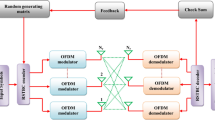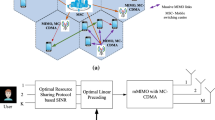Abstract
In a 4G cellular communication system, energy efficiency and power consumption are the key parameters in evaluating and designing communication system in multimedia. In this paper, an efficient model with high energy is proposed for multiple input multiple output orthogonal frequency division multiplexing (MIMO–OFDM) mobile multimedia systems with less power consumption. Providing high-speed video coding technique, which is designed to substantially improve coding efficiency compared with other coding techniques. Next to that erasures coding and Wyner–Ziv coding is used for encoding and compression process. Finally, efficient energy based optimized power allocation with hybrid Fuzzy Grey Wolf Optimization (GWO) algorithm is presented to reduce the power consumption of MIMO–OFDM mobile multimedia communication systems. The value of power which is consumed at the 30th iteration is 20 W and the energy efficiency is 92% for the 20 W power. Experimental results show that the proposed hybrid Fuzzy GWO algorithm can assure the required service with maximum efficiency in MIMO–OFDM.










Similar content being viewed by others
References
Paulraj, A. J., et al. (2004). An overview of MIMO communications-a key to gigabit wireless. Proceedings of the IEEE,92(2), 198–218.
Xiong, K., Fan, P., Zhang, C., & Letaief, K. B. (2015). Wireless information and energy transfer for two-hop non-regenerative MIMO–OFDM relay networks. IEEE Journal on Selected Areas in Communications,33(8), 1595–1611.
Li, X., Li, C., & Jin, Y. (2016). Dynamic resource allocation for transmit power minimization in OFDM-based NOMA systems. IEEE Communications Letters,20(12), 2558–2561.
Zhou, L., Zhu, C., Ruby, R., Wang, X., Ji, X., Wang, S., et al. (2017). QoS-aware energy-efficient resource allocation in OFDM-based heterogeneous cellular networks. International Journal of Communication Systems,30(2), e2931.
Wang, Z., Wen, C., Fan, Z., & Wan, X. (2018). A novel price-based power allocation algorithm in non-orthogonal multiple access networks. IEEE Wireless Communications Letters,7(2), 230–233.
Ren, Z., Chen, S., Hu, B., & Ma, W. (2014). Energy-efficient resource allocation in downlink OFDM wireless systems with proportional rate constraints. IEEE Transactions on Vehicular Technology,63(5), 2139–2150.
Ning, B., Yang, S., Liu, L., & Lu, Y. (2014). Resource allocation for OFDM cognitive radio with enhanced primary transmission protection. IEEE Communications Letters,18(11), 2027–2030.
Xu, L., Qian, F., Li, Y., Li, Q., Yang, Y.-W., & Xu, J. (2016). Resource allocation based on quantum particle swarm optimization and RBF neural network for overlay cognitive OFDM System. Neurocomputing,173, 1250–1256.
Krishnan, K. V., Sajith, R. M., & Khara, S. (2015). Dynamic resource allocation in OFDM based cognitive radio system considering primary user QoS and secondary user proportional constraints. Journal of Communications Technology and Electronics,60(11), 1269–1275.
Xiao, X., Tao, X., & Lu, J. (2015). Energy-efficient resource allocation in LTE-based MIMO–OFDMA systems with user rate constraints. IEEE Transactions on Vehicular Technology,64(1), 185–197.
She, C., Yang, C., & Liu, L. (2015). Energy-efficient resource allocation for MIMO–OFDM systems serving random sources with statistical QoS requirement. IEEE Transactions on Communications,63(11), 4125–4141.
Bal, R., Bakshi, A., & Gupta, S. (2019). Performance evaluation of optimization techniques with vector quantization used for image compression. Harmony search and nature inspired optimization algorithms (pp. 879–888). Singapore: Springer.
Bouchemel, A., Abed, D., & Moussaoui, A. (2018). Enhancement of compressed image transmission in WMSNs using modified μ-nonlinear transformation. IEEE Communications Letters,22(5), 934–937.
Ali, H. S., Atallah, A. M., & Abdalla, M. I. (2017). An efficient source–channel coding for wireless image transmission over underwater acoustic channel. Wireless Personal Communications,96(1), 291–302.
Kazemian, M., Varahram, P., Hashim, S. J., Ali, B. M., & Farrell, R. (2018). A low complexity peak-to-average power ratio reduction scheme based on selected mapping and radix-II IFFT in OFDM systems. Telecommunication Systems,67(1), 21–30.
Kim, S., & Lee, Y. H. (2015). Energy-efficient power allocation for OFDM signaling over a two-way AF relay. IEEE Transactions on Vehicular Technology,64(10), 4856–4863.
Li, X., Ge, X., Wang, X., Cheng, J., & Leung, V. C. M. (2016). Energy efficiency optimization: Joint antenna-subcarrier-power allocation in OFDM-DASs. IEEE Transactions on Wireless Communications,15(11), 7470–7483.
Han, J., Zhang, L., & Leus, G. (2016). Partial FFT demodulation for MIMO–OFDM over time-varying underwater acoustic channels. IEEE Signal Processing Letters,23(2), 282–286.
You, C. (2018). Near-lossless compression/decompression algorithms for digital data transmitted over fronthaul in C-RAN. Wireless Networks,24(2), 533–548.
Peng, M., Yu, Y., Xiang, H., & Poor, H. V. (2016). Energy-efficient resource allocation optimization for multimedia heterogeneous cloud radio access networks. IEEE Transactions on Multimedia,18(5), 879–892.
Ge, X., Huang, X., Wang, Y., Chen, M., Li, Q., Han, T., et al. (2014). Energy-efficiency optimization for MIMO–OFDM mobile multimedia communication systems with QoS constraints. IEEE Transactions on Vehicular Technology,63(5), 2127–2138.
Bu, S., & Yu, F. R. (2014). Green cognitive mobile networks with small cells for multimedia communications in the smart grid environment. IEEE Transactions on Vehicular Technology,63(5), 2115–2126.
Wang, Q., Wang, W., Jin, S., Zhu, H., & Zhang, N. T. (2015). Quality-optimized joint source selection and power control for wireless multimedia D2D communication using Stackelberg game. IEEE Transactions on Vehicular Technology,64(8), 3755–3769.
Chen, X., Hwang, J.-N., Lee, C.-N., & Chen, S.-I. (2015). A near optimal QoE-driven power allocation scheme for scalable video transmissions over MIMO systems. IEEE Journal of Selected Topics in Signal Processing,9(1), 76–88.
Zhou, H., Mao, S., & Agrawal, P. (2015). Optical power allocation for adaptive transmissions in wavelength-division multiplexing free space optical networks. Digital Communications and Networks,1(3), 171–180.
Hemalatha, R., Radha, S., & Sudharsan, S. (2015). Energy-efficient image transmission in wireless multimedia sensor networks using block-based compressive sensing. Computers & Electrical Engineering,44, 67–79.
Sheikh, J. A., Parah, S.A., & Bhat, G. M. (2017). Energy efficient image transmission through orthogonal frequency division multiplexing (OFDM) based multiple input multiple output (MIMO) systems. In 2017 fourth international conference on image information processing (ICIIP) (pp. 1–6). IEEE.
Eraslan, E., & Daneshrad, B. (2017). Low-complexity link adaptation for energy efficiency maximization in MIMO–OFDM systems. IEEE Transactions on Wireless Communications,16(8), 5102–5114.
Guo, R., Zhu, P., Li, J., Wang, D., & You, X. (2019). Energy optimization algorithms for MIMO–OFDM based downlink C-RAN system. IEEE Access,7, 17927–17934.
Chen, M., Xiao, X., Li, X., Yu, J., Huang, Z. R., Li, F., et al. (2016). Improved BER performance of real-time DDO-OFDM systems using interleaved Reed-Solomon codes. IEEE Photonics Technology Letters,28(9), 1014–1017.
Shirato, Y., & Muraguchi, M. (2016). Signal decomposition technique for enhanced power added efficiency of OFDM transmitters and its application for MIMO systems. In 2016 46th European microwave conference (EuMC) (pp. 146–149). IEEE.
He, J., Li, B., Deng, L., Tang, M., Gan, L., Fu, S., et al. (2016). Experimental demonstration of bidirectional OFDM/OQAM-MIMO signal over a multicore fiber system. IEEE Photonics Journal,8(5), 1–8.
Krishna, C. M., Somasekhar, B., & Swaroop, V. S. (2017). A study on PAPR reduction and channel estimation in MIMO–OFDM system using wavelet transform. In 2017 international conference on energy, communication, data analytics and soft computing (ICECDS) (pp. 1707–1711). IEEE.
Xing, C., Ma, S., & Zhou, Y. (2015). Matrix-monotonic optimization for MIMO systems. IEEE Transactions on Signal Processing,63(2), 334–348.
He, X., Song, R., & Zhu, W. P. (2016). Pilot allocation for distributed-compressed-sensing-based sparse channel estimation in MIMO–OFDM systems. IEEE Transactions on Vehicular Technology,65(5), 2990–3004.
Manzoor, S., & Othman, N. S. (2017). Signal to noise ratio estimation in OFDM based cooperative communication system. In 2017 IEEE 13th Malaysia international conference on communications (MICC) (pp. 84–89). IEEE.
Gross, J., Klaue, J., Karl, H., & Wolisz, A. (2004). Cross-layer optimization of OFDM transmission systems for MPEG-4 video streaming. Computer Communications,27(11), 10.
Author information
Authors and Affiliations
Corresponding author
Additional information
Publisher's Note
Springer Nature remains neutral with regard to jurisdictional claims in published maps and institutional affiliations.
Rights and permissions
About this article
Cite this article
Sharma, P., Dhubkarya, D.C. An Energy Efficient OFDM–MIMO Systems for Multimedia Data Transmission Based on Hybrid Fuzzy Approach. Wireless Pers Commun 112, 1431–1450 (2020). https://doi.org/10.1007/s11277-020-07109-4
Published:
Issue Date:
DOI: https://doi.org/10.1007/s11277-020-07109-4




